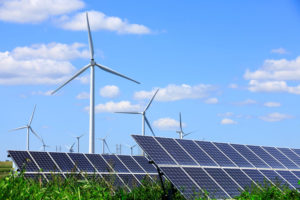Spiking oil and gas prices have put a new spotlight on alternative energy sources; in particular, how their costs have come down in recent years to become competitive with fossil fuels. The most common measure, used by the U.S. Energy Information Administration, looks at your electric utility bill and then compares the cost of various energy sources to produce the juice that flows through the grid into your home.
This can be a tricky calculation, because the price of electricity varies—a lot—from region to region across the United States. The average residential cost is 13.04 cents per kilowatt hour (kWh), but people in Hawaii and Alaska pay 29.18 cents and 19.36 cents respectively for that same kilowatt hour. In Massachusetts, the average cost is 18.5 cents, while people in Louisiana and Arkansas pay less than 8 cents per kWh.

Nevertheless, if you look at the overall costs of producing a million watt hours from different kinds of electric plants, it’s possible to compare apples to apples. Why this measure, it costs just $39.1 to produce one MVWh using hydroelectric power—basically harnessing waterfalls. At the other end of the spectrum, coal-powered plans are now running at between $98 and $104 per MVWh, and the most recent U.S. Energy Information Administration report suggests that we may not see any further coal-powered power plans constructed in the U.S.
Solar power, meanwhile, is estimated to cost just $60 per MVWh. This calculation includes the various costs of panels and installation. What’s striking is that solar energy is now, for the first time, cheaper than natural gas ($67.5)—and it is notable that this calculation was made before the recent oil and gas price spikes. As you can see from the chart, which was compiled several years ago, the solar industry has made enormous cost reductions since 2009, while other energy sources have remained roughly stable. (Notice that nuclear has become more expensive during that time period.)
For residential consumers, the story is the same, but with different numbers. The Energy Information Administration recently calculated, using current costs of solar panels and installation, assuming a 25-year life for the panels and a 12-year life for converters, estimated that the average consumer in a moderately sunny environment (basically meaning not Seattle), will experience a net monthly savings of $84 a month, and break even on the installation costs after 10.8 years. Another study found that the electricity cost of a home with solar panels installed, again with average sunlight, is 8.1-8.7 cents/kWh—and estimates that by 2030 that price will have come down to just four cents.
Weaning our economy from Russian oil and gas—and ultimately from oil and gas entirely—may not be as painful as we might have imagined. As more utilities adopt the cost savings of solar, creating demand for solar panel production, expect the price of those panels to come down—and energy prices with them.
Sources:
https://www.energy.gov/eere/solar/sunshot-2030
http://solarcellcentral.com/cost_page.html
https://www.energy.gov/eere/solar/articles/2030-solar-cost-targets
